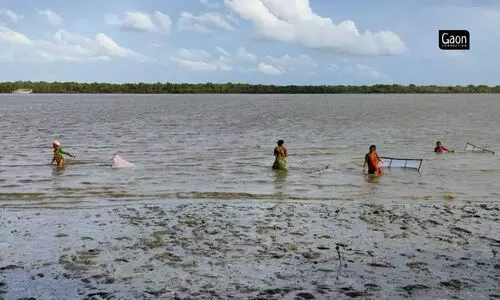Gosaba (South 24 Parganas), West Bengal
In the heart of one of the world’s largest mangrove forests, the tough-as-nails grandmother stood in neck-deep water – her workplace where a hundred thousand women brave crocodiles, snakes and even tigers to earn a living.
Yashoda Mondol, 72, has a routine that would put a gym goer to shame.
Standing on the swampy mudflats of the Sundarbans, calf-deep in mud, Mondol dragged a large rectangular fishing net frame behind her in muddy waters. A large part of her day is spent repeating this exercise as the 72-year-old laboriously works to catch and sell bagda or wild tiger prawn seedlings for a living. She repeats her manoeuvres at least 20 times before she has enough seedlings to fetch her money — Rs 100 a day — to buy food. Their menfolk have migrated to other states.
Tiger prawns lay their eggs in the rivers and creeks of the Sundarbans archipelago. The meendharas trap them as they make their way back to the sea. Collecting prawn seedlings from rivers and creeks is a dangerous yet important livelihood source for more than a lakh of poor women in the Sundarbans, the largest expanse of continuous mangrove forests in the world located at the confluence of the rivers Ganga, Brahmaputra and Meghna that flow into the Bay of Bengal.
“92, 93, 94…,” Mondol counted loudly. “The middleman will pay me Rs 200 for 1,000 bagda,” she told Gaon Connection. Her monthly income rarely crosses Rs 2,000.
The women are locally known as meendharas – literally “fish catchers”. Living in the villages near the mangroves of the Sundarbans, they brave great dangers to collect wild tiger prawn seedlings. The muddy waters are infested with snakes and estuarine crocodiles, and unpredictable tides. Not to mention tigers.
“Once the bagh (tiger) swam across the river and reached the shore where I was catching bagda. I just shut my eyes and recalled Bonbibi. I told the bagh to go on his way and let me go mine. He left me unharmed,” Mondol recalled.
Bonbibi or the goddess of the jungle is considered a protector by fisherfolk and forest-dependent communities of the Sundarbans.
But Mondol has lost at least five of her women relatives to kumbhir or croc attack while they were collecting prawn seedlings.
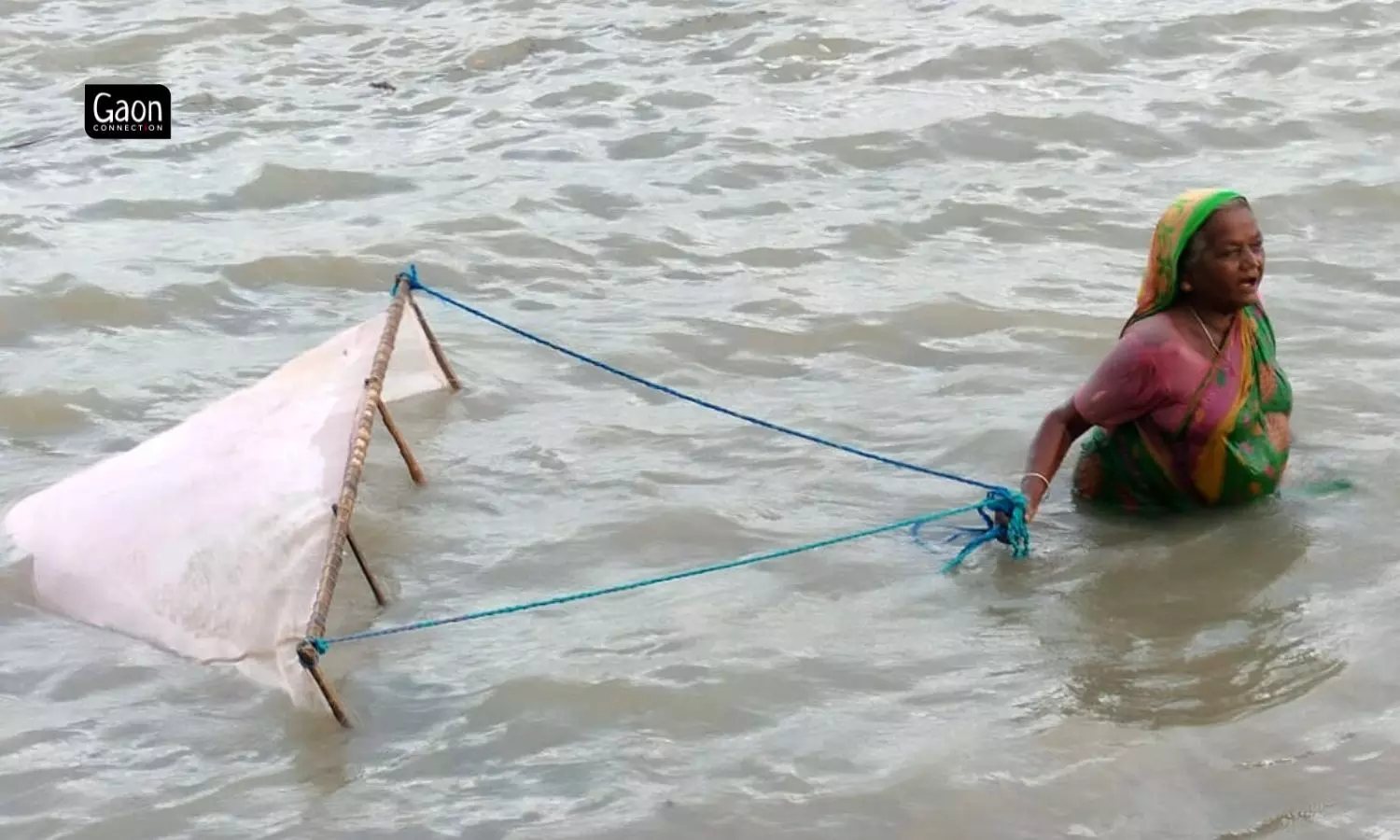
Yashoda Mondol is the oldest in the group of six prawn seedling collectors from her village who venture out together into the Bidyadhari river during low tide.
She herself has survived being bitten by water snakes several times.
“It is fate. If I am to die in the river, I will,” she said.
When Mondol had started out collecting prawn seedlings as a young girl of ten, she didn’t know how to count beyond 20.
“I used to group them in their 20s and count. But now I am fluent. Test me — I can count 10,000 prawn seedlings in no time,” she smiled.
Mondol is the oldest in the group of six prawn seedling collectors from her village who venture out together into the Bidyadhari river during low tide. The river flows next to her village Sonagar in Gosaba block in the Sundarbans, the largest expanse of continuous mangrove forests in the world located at the confluence of the rivers Ganga, Brahmaputra and Meghna that flow into the Bay of Bengal.
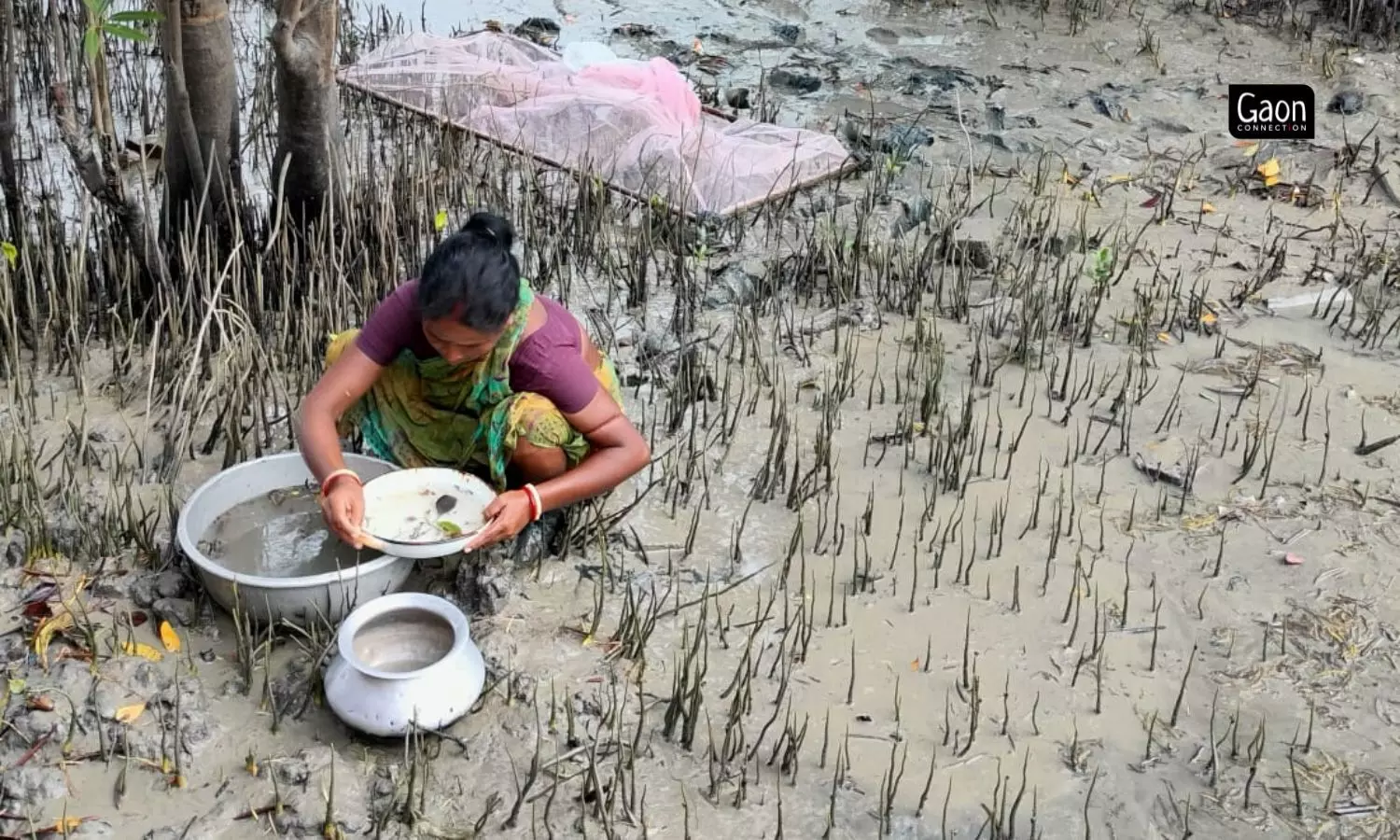
The seedlings are collected into an aluminium tasla (bowl) full of water. The meendharas sort and clean the seedlings, separating them from the other detritus from the river.
The Sundarbans archipelago contains over 4.4 million of the most impoverished and vulnerable people in India. About half of this population lives below the poverty line, with poverty incidence highest in the blocks close to the vast mangrove forest.
The majority of the menfolk from the Sundarbans migrate long distances to states such as Andhra Pradesh, Tamil Nadu and Kerala to work as labourers, leaving behind women to look after the homes and families.
Poverty and lack of education forces these women to work as prawn seedling collectors.
If these women aren’t careful, they can easily miss the brown hair-like prawn seedlings that are less than an inch-long.
The seedlings are collected into an aluminium tasla (bowl) full of water. Mondol sorts and cleans the seedlings, separating them from the other detritus from the river and then sells them to the middlemen who come from as far as Kolkata, the state capital.
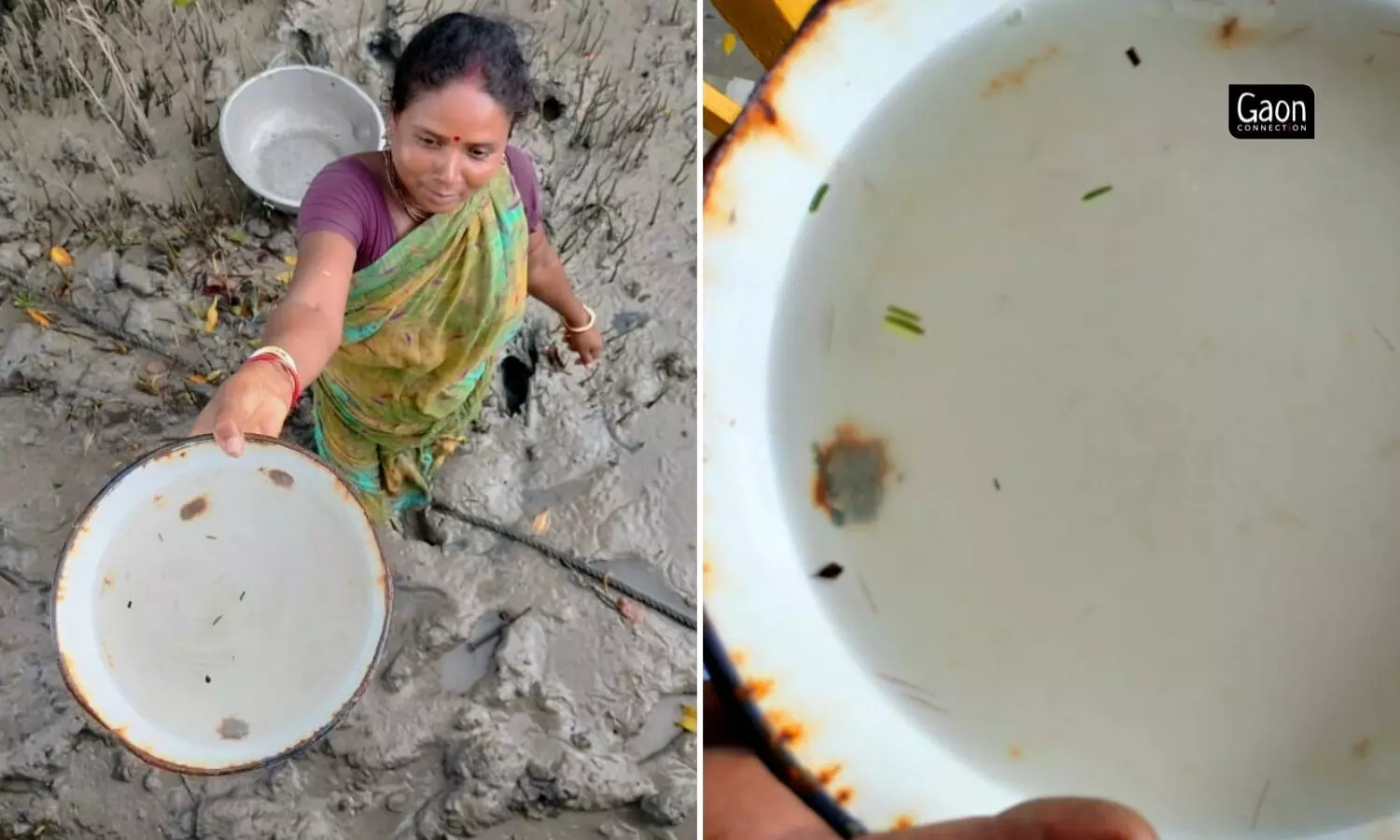
If these women aren’t careful, they can easily miss the brown hair-like prawn seedlings that are less than an inch-long.
It is meendharas like Mondol, the poorest of the poor women, who have helped position West Bengal as the highest producer of tiger shrimp in India, producing 50,000 tonnes from an area of 51,000 hectares.
“The men don’t do this,” Mondol shrugged at the question. Many of them, like her son Khogem Mondol, migrate elsewhere to find work. Khogem went off to Andhra Pradesh.
“It is the women who are left behind to fend for themselves and take care of their families,” she said.
Also Read: Who moved my village?
The ones left behind
“There are only a few cases, maybe five per cent, where the wife or the family goes along but mostly it is the men. Every third household, has a migrant between the ages of 16 and 40 years,” Dr Sugata Hazra, Director, School of Oceanographic Sciences at Jadavpur University, Kolkata, told Gaon Connection. The women usually are left behind on the islands to look after the children and the older people, he added.
Circular migration is the preferred mode in Sundarbans in which the migrants return home only to migrate again, as explained in a research conducted in December 2022.
The report noted that while the men coped with livelihood uncertainties mainly through seasonal out migration, women coped with whatever available livelihood options, such as prawn seedling collection, they found within the island.
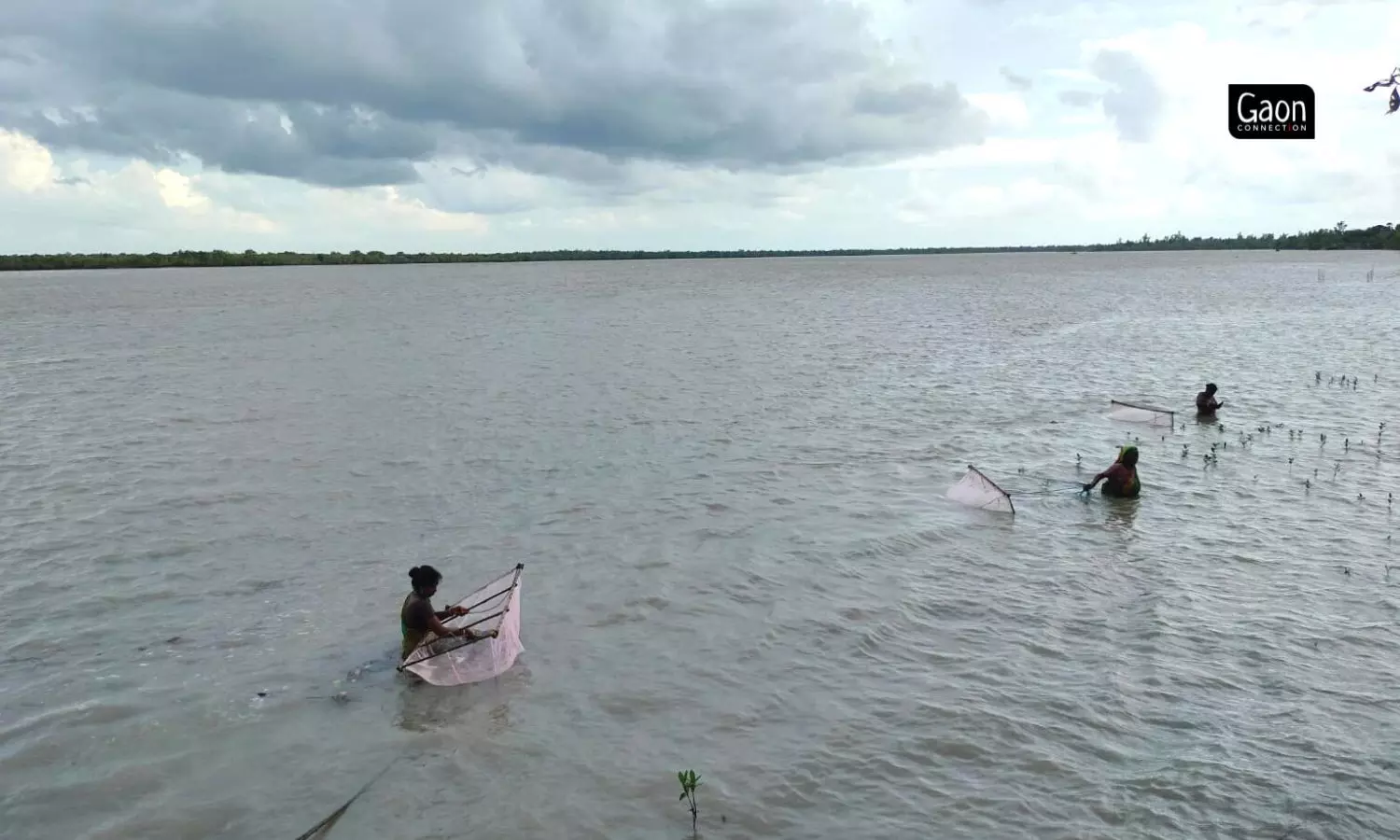
While the men coped with livelihood uncertainties mainly through seasonal out migration, women coped with whatever available livelihood options, such as prawn seedling collection.
“More people die in crocodile attacks in the Sundarbans than tiger attacks. But what other livelihoods do they have? This crab catching and prawn fish collection are their only options. They see it as a low-hanging fruit,” Hazra explained.
Bagda catching depends on the tides and based on the moon’s position; low tides are the best for a good catch.
Mondol along with her daughter-in-law Chandna Mondol and grand-daughter Devika Burman, go to Bidyadhari river every day at low tide in search of seedlings — sometimes at the crack of dawn, other times at sunset.
The three women often leave home at about 3 am and return by 9.30 am. They will return to the waters once again later in the day at about 5 pm.
Lowest in the ladder
The prawn seedling catchers, mostly women like Mondol, Chandna and Devaki are the lowest in the ladder of economic value of the tiger prawns.
After backbreaking work, the women sell their catch to the local middlemen Jananranroy Jana for cultivation in bheries or large artificial enclosures for brackish water aquaculture in Canning, Jibantala, and other places in the South 24 Parganas district.
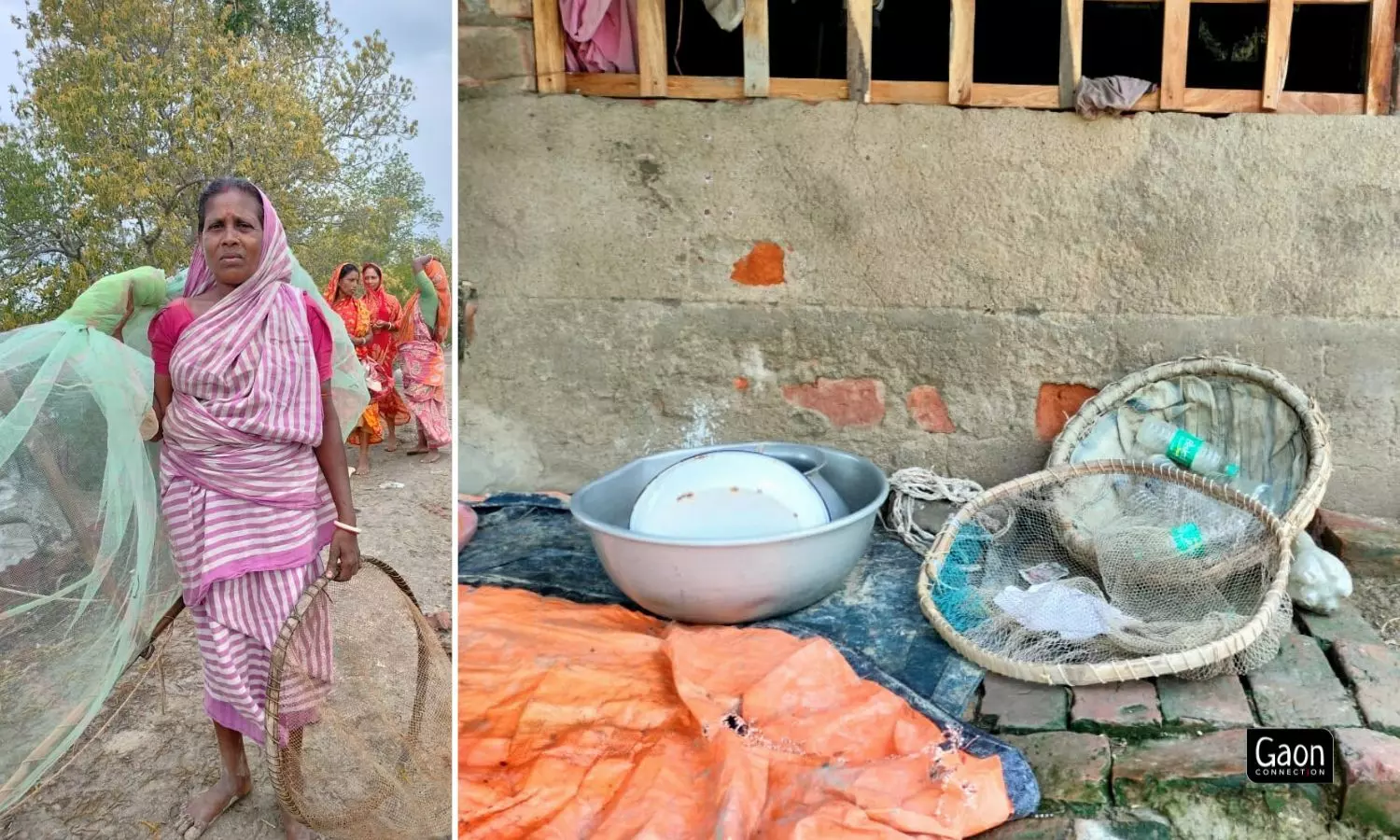
After backbreaking work, the women sell their catch to the local middlemen Jananranroy Jana for cultivation in bheries or large artificial enclosures for brackish water aquaculture.
The bagda is cultivated for three to four months in these bheries, after which they are sold in wholesale markets and later moved to the export market. The chain beyond the job of catching prawn seedling is mostly handled by men, as the women are not equipped to do that themselves.
“Anything beyond catching these seedlings needs a bigger setup which we don’t have,” said Mondol’s 33-year-old granddaughter Devika.
She is separated from her husband and it is for the sake of her two children eight-year-old Joyboro and 11-year-old Joysree, that she continues with her low-paying work.
“I work for 10 to 12 hours a day and never make more than Rs 100 per day on an average,” Devika told Gaon Connection.
“If there was any other work available to me, I would never do this.”
This is the first part of a two-part series. You can read the second part here. The article is written under the Laadli Media Fellowship, 2023. All the opinions and views expressed are those of the author. Laadli and UNFPA do not necessarily endorse the views.

